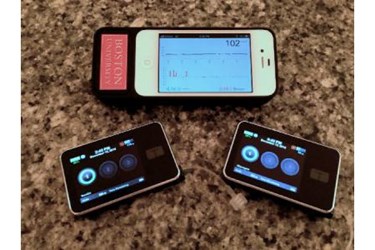Bionic Pancreas Leverages Smartphone, Pumps To Control Blood Sugar
By Joel Lindsey

Researchers at Boston University (BU) and Massachusetts General Hospital (MGH) are developing a new bionic pancreas device to provide constant glucose monitoring and administer doses of insulin or glucagon to patients with type 1 diabetes.
The new device brings together smartphone technology and two wearable pumps to administer insulin when blood sugar levels are too high and the hormone glucagon when levels dip too low. Every five minutes, the smartphone receives a blood sugar measurement from a continuous glucose monitor. Using a specially designed software program, the smartphone uses this data to make decisions about whether to use the wearable pumps to administer either insulin or glucagon.
“The most practical difference would be not having to think about diabetes 24/7, not having to constantly make decisions about things that those of us without type 1 never have to think about,” Edward Damiano, a member of the BU Department of Biomedical Engineering and principal investigator of the project, said in a recent press release. “And another extremely frustrating aspect of diabetes that would be completely eliminated by this device is the enormous sense of failure when you stare at that glucose meter and, despite everything you do to control it, your blood sugar is not in or near the normal range. But of course you didn’t fail; the tools that are available to you failed.”
The smartphone app also allows users to enter information regarding their eating habits in order to help them more precisely and thoroughly manage their blood sugar levels. To use this feature, users enter in some basic information — including whether the meal being eaten is breakfast, lunch, or dinner — and whether the amount of carbohydrates in the meal is normal or larger or smaller than normal.
“The key element with the current version of this device is that it’s wearable, allowing participants to stay in something close to their usual environments, exercise, and eat whatever they want,” said Steven Russell, MD, of the MGH Diabetes Unit.
Researchers recently conducted two studies using the new device, one with adults and the other with adolescents. The focus of these studies was to see how well the device worked while wearers went about activities that resembled their normal everyday routines.
Results from these tests were published in The New England Journal of Medicine.
“Participants’ average blood glucose went down while the incidents of low blood sugar also dropped,” said Russell. “The fear of hypoglycemia can limit attempts to bring the average blood sugar into the range that dramatically reduces the risk of long-term complications, so it was remarkable that we saw both of these result at once.”
“Both groups had quite good levels in the usual care arms — averages of 159 for both adults and adolescents — but the difference while they were on the bionic pancreas was dramatic, with average blood sugar levels of 133 for the adults and 142 for adolescents.”
Image credit: Boston University Department of Biomedical Engineering
